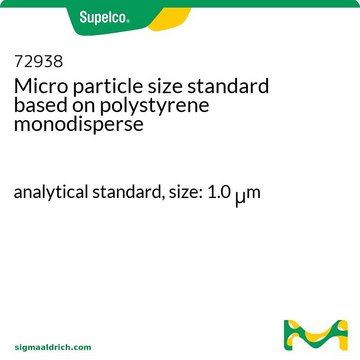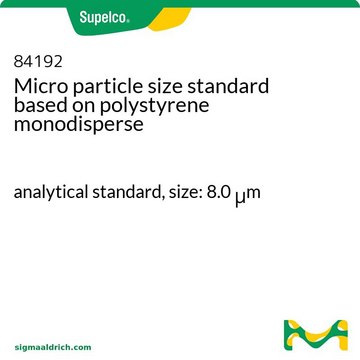80304
Micro particle size standard based on polystyrene monodisperse
analytical standard, size: 3.0 μm
Synonim(y):
Monodyspersyjne cząstki lateksu polistyrenowego (3 μm), monodyspersyjne mikrokulki polistyrenowe (3 μm), monodyspersyjne mikrosfery polistyrenowe (3 μm)
About This Item
Polecane produkty
klasa czystości
analytical standard
Poziom jakości
Formularz
aqueous suspension
particles
sieciowanie krzyżowe
0 % cross-linked
stężenie
2% (solids)
wielkość cząstki
3.0 μm std dev <0.1 μm, coeff var <2%
Zastosowanie
glass & ceramic
industrial qc
pharmaceutical
Format
neat
temp. przechowywania
2-8°C
Szukasz podobnych produktów? Odwiedź Przewodnik dotyczący porównywania produktów
Opis ogólny
Zastosowanie
Używany również:
- w pułapkach akustycznych do badania wpływu bezkontaktowej retencji mikrocząstek na wydajność pułapkowania systemów laboratoryjnych na chipach
- do syntezy interferometrycznej sondy optycznej opartej na mikrosferach o nazwie reflektofor
Cechy i korzyści
- nadaje się do rutynowych kontroli i korekt kalibracji urządzeń
- dostępny w opakowaniu 5 ml jako czysta próbka
Komentarz do analizy
.
- Transmisyjna mikroskopia elektronowa (TEM)
- Skaningowy mikroskop elektronowy
- Mikroskopia świetlna
- Licznik1773 z systemem MDF
Informacje prawne
Kod klasy składowania
10 - Combustible liquids
Klasa zagrożenia wodnego (WGK)
WGK 3
Temperatura zapłonu (°F)
410.0 °F
Temperatura zapłonu (°C)
210 °C
Środki ochrony indywidualnej
Eyeshields, Gloves
Wybierz jedną z najnowszych wersji:
Masz już ten produkt?
Dokumenty związane z niedawno zakupionymi produktami zostały zamieszczone w Bibliotece dokumentów.
Klienci oglądali również te produkty
Nasz zespół naukowców ma doświadczenie we wszystkich obszarach badań, w tym w naukach przyrodniczych, materiałoznawstwie, syntezie chemicznej, chromatografii, analityce i wielu innych dziedzinach.
Skontaktuj się z zespołem ds. pomocy technicznej












